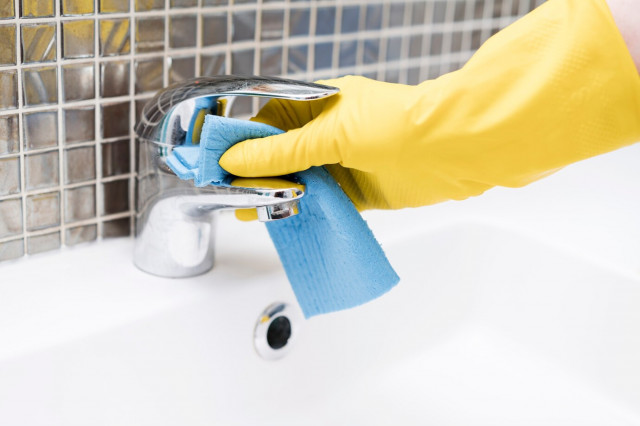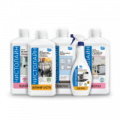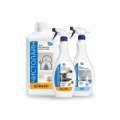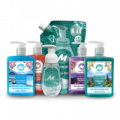White plaque: how to remove from plumbing surfaces?
Ways to clean the faucet from limescale

Content
For many people, limescale is a serious problem. It occurs on grout lines and tiles, covers the faucet and other surfaces. As a result, the room looks unsightly, and the plumbing begins to deteriorate - it is subject to corrosion processes. But it is quite possible to remove plaque from the faucet and other surfaces - you just need to set a goal and stock up on suitable household chemicals. Let's try to figure out how to deal with this problem in a little more detail.
Why does white plaque appear?
The main reason for the formation of plaque lies in the mineral composition of tap water. If it contains a significant amount of salts, incl. calcium and magnesium, then when drying, it leaves behind white spots. If they are not removed in a timely manner, over time they thicken and form scale. It is already quite difficult to wash it.
Plaque can appear on absolutely any surfaces where water droplets fall. It looks unsightly and, as we said above, can disrupt the functionality of plumbing. If plaque accumulates on the components of the shower stall, they can also become unusable over time. Therefore, the question of how to clean the faucet from scale and how to tidy up the entire bathroom is very relevant.
Folk remedies: recipes and their shortcomings
Thinking about how to clean plaque on the faucet, many people want to save money and at the same time get an excellent result. But, unfortunately, this is not always possible. There are many folk remedies that are designed to fight plaque, but many of them have certain drawbacks. Among the TOP folk remedies for scale on the faucet:
- Soda. A box of baking soda can be found in every kitchen. And this abrasive agent can be used to clean walls (including tiles), shower stalls and faucets from limescale. You need to rub the surfaces. After that, the product is washed off with ordinary water. It should be borne in mind that the abrasiveness of soda can lead to mechanical damage on the shiny chrome or matte surface of plumbing. And without friction, soda will not give such a positive effect - it can neutralize only small stains, but cannot cope with serious limescale.
- Soda and soap. It is assumed that the combination of these components should give a mutually reinforcing effect. You need to take a bar of solid soap and grate it, and then combine it with soda in the same proportion and dilute with a small amount of hot water to a pulp. This mass should be applied to a clean sponge and rub the plumbing and other surfaces with it.A faucet debris remover has many drawbacks. Firstly, it requires the use of additional improvised means for cooking (the same grater), and secondly, it has some abrasive properties - it can leave the smallest scratches on surfaces. In addition, soap itself can leave soap streaks after rinsing. And it is not able to cope with dense and old lime deposits.
- Vinegar. Ordinary table vinegar is often recommended to clean the faucet from plaque. And as practice shows, 9% of the product removes limescale stains quite well. But, unfortunately, it is not enough to dissolve dense deposits. To do this, the affected objects need to be dipped in vinegar for a while, which is simply impossible in the bathroom. Not everyone likes it.
- Citric acid. It works on the same principle as vinegar. It is worth diluting it with a small amount of clean water to get a gruel, and apply a sponge to problem areas. Such a remedy for limescale can easily remove minor dirt. However, it can also leave behind small damage (small scratches), and in the fight against dense deposits it may not be effective at all.
Thus, folk remedies for removing limescale do not always give the expected result. At the same time, their use requires a certain amount of effort from a person - even the simplest recipes involve kneading, rubbing, and long exposure on surfaces. Therefore, it is better not to experiment and entrust your bathroom with good household chemicals.
What means will help get rid of plaque reliably?
When choosing how to remove limescale from the faucet, it is worth giving preference to specialized products that were created precisely to achieve perfect cleanliness and shine in the bathroom. They are easy to use, do an excellent job, do not leave streaks, but at the same time have a pleasant unobtrusive aroma. An excellent choice would be:
- Chistolain anti-scale. This product is able to cope even with stubborn deposits of limescale. It can be safely used to tidy up various surfaces, including surfaces made of stainless steel, glass, ceramics or plastic. It is non-abrasive and does not damage even sensitive materials. It can be applied to shower stalls, taps, bathroom tiles, etc.
- Chistolain Bathroom. This product will be preferable for complex cleaning - it will eliminate not only fresh or old limescale, but also cope with soap stains, traces of toothpaste and urinary calculus.
- Chistolain WC. It will help to quickly and effectively put the toilet bowl in order, even if it has a pronounced limescale and urinary calculus. It acts quickly, copes even with stubborn dirt, while not leaving scratches.
High-quality household chemicals will come in handy for maintaining order in any apartment, office and private house. It can also be used in the HoReCa sector - hotels, restaurants and cafes.






